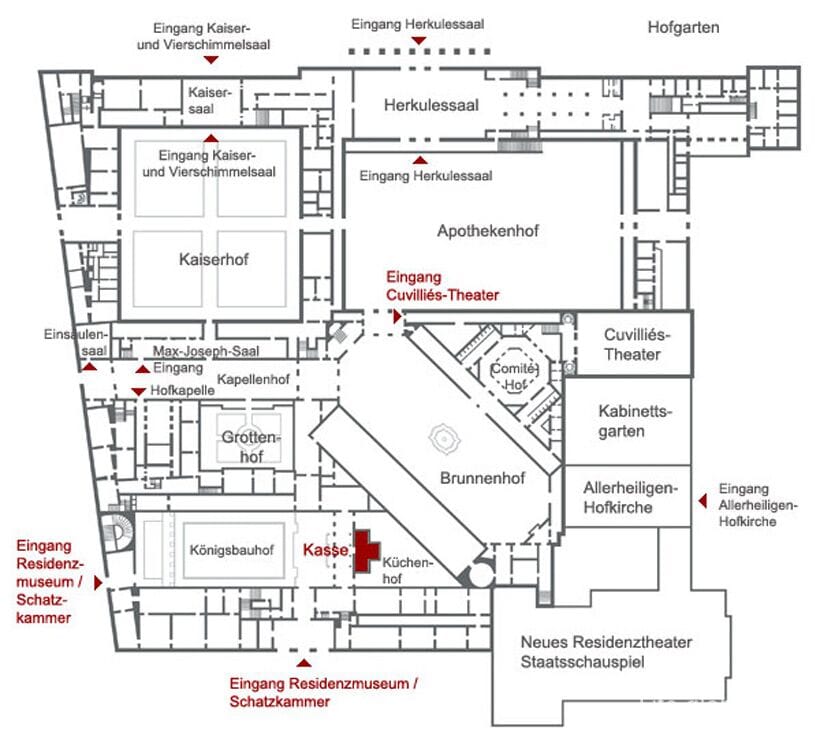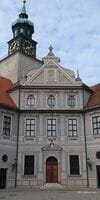Munich residence (Münchner Residenz) - the historic residence of the Dukes, electors and kings of Bavaria, the largest inner-city Palace in Germany.
Today Munich is one of the most important art museums in Europe.
Residence is sometimes also called a residence (Palace) of the Bavarian kings or the residence of the Wittelsbach.
Munich has more than 635 years of history and replaced the Old courtyard (Alter Hof / Alter Hof) - the former fortress and castle that has ceased to be a reliable and roomy shelter.
The first residence dates back to 1385, and starting with the Gothic castle Naivete (Neuveste), which was used as a refuge for the ruling Dukes and was a fortress surrounded by water.
During the history of the residence was repeatedly rebuilt, restored and expanded, thus there were new buildings, courtyards and gardens, and the Palace complex was turned into a luxurious Palace of the rulers and, eventually, lost fortification character.
Its current appearance residence received under the king of Bavaria Ludwig I.
Under king Ludwig III were made technical improvements of the Palace, such as electric lighting and Central heating.
The Palace was badly damaged during the Second world war. Later the residence was restored, some rooms were rebuilt in a simplified form.
Today, the Residenz is a complex of buildings with courtyards, a Palace Church and the surrounding gardens and internal rooms of the residence is used for receptions and concerts, they are also located: the residence Museum, the Treasury, the Munich state collection of coins, library, cuvillies-theater and the Bavarian Academy of Sciences.
In the plan, the Munich residence is divided into three main parts (set):
- the old residence or the residence of Maximilian / Maximiliansau residence (Alte Residenz, Residenz Maximilianische), which is located towards the street Residenzstraße and with which began the history of the residence as a representative Palace.
This part of the residence was created by Duke Maximilian I and that, in his honor, also called the residence of Maximilian.
Two portals (entrances) to the facade of the Old residence of the notable statues of lions guarding the portals and the statue of our lady in the way Cartridges of Bavaria, located in a niche of the walls between the portals.
Both portals lead into the courtyards of the residence;
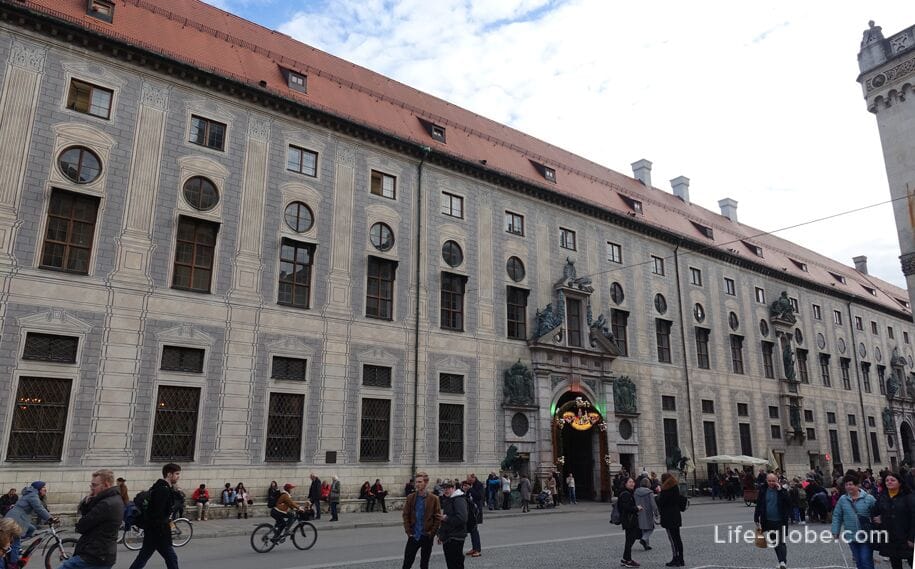
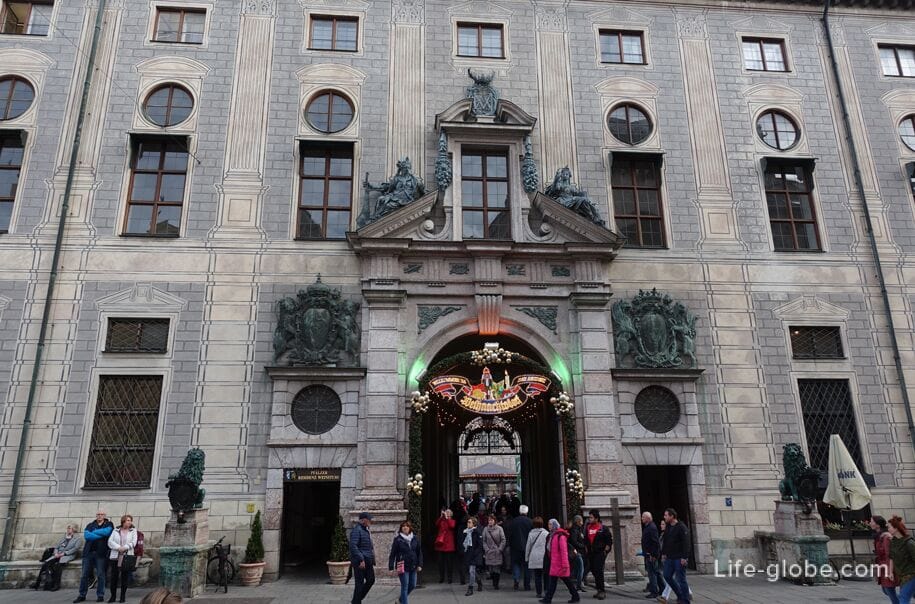
- Royal quarters (Königsbau / Konigsbau) located near the area of max Joseph (Max-Joseph-Platz) and a more modern building, built during the reign of Ludwig I (between 1825 and 1835) in the style of the Palazzo Petti.
Within the walls of this part of the residence there were numerous suites, including flat Ludwig I and winter garden;
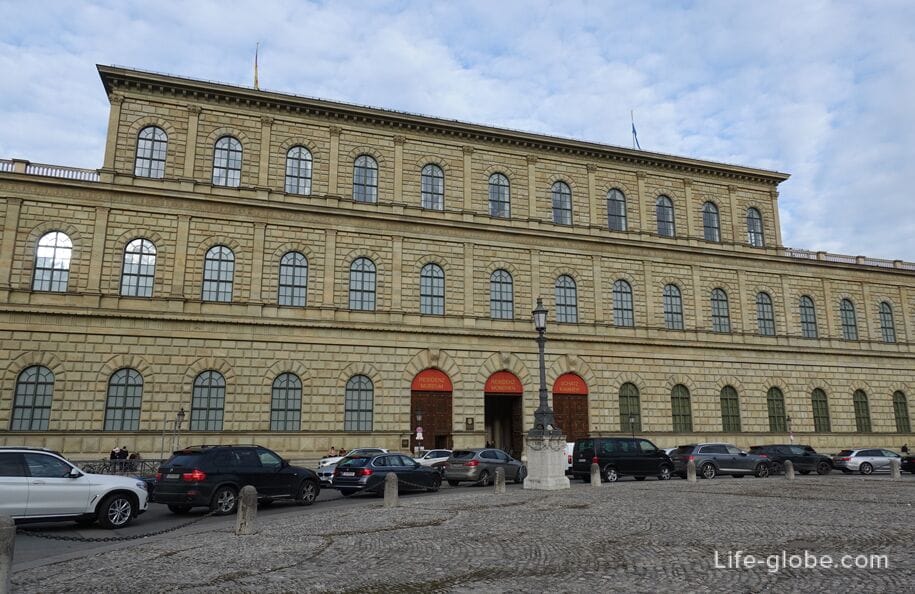
- festive hall (Festsaalbau / Festsaalbau), the facade facing the adjacent court Park Hofgarten () and represents the neoclassical wing of the Banquet hall with a length of 250 meters, which was added between 1832 and 1842 on the orders of king Ludwig I.
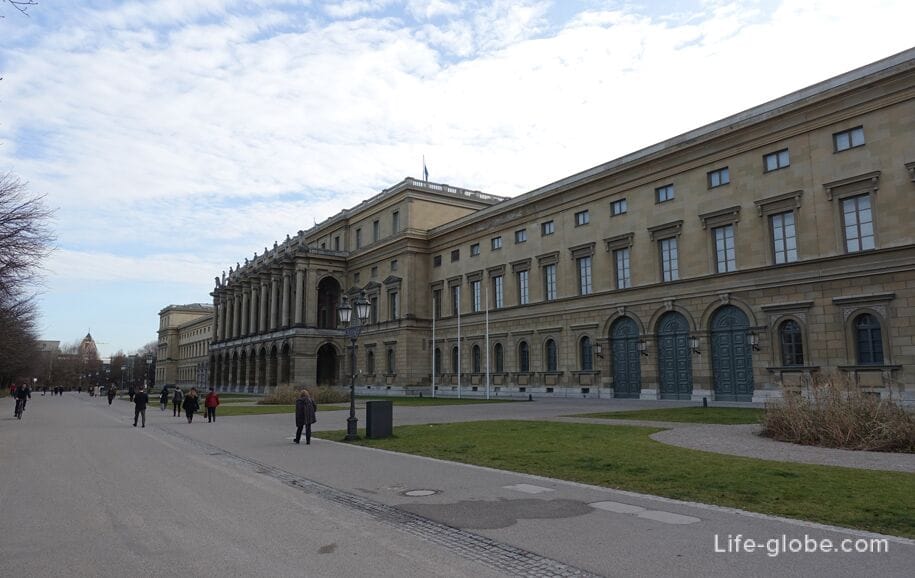
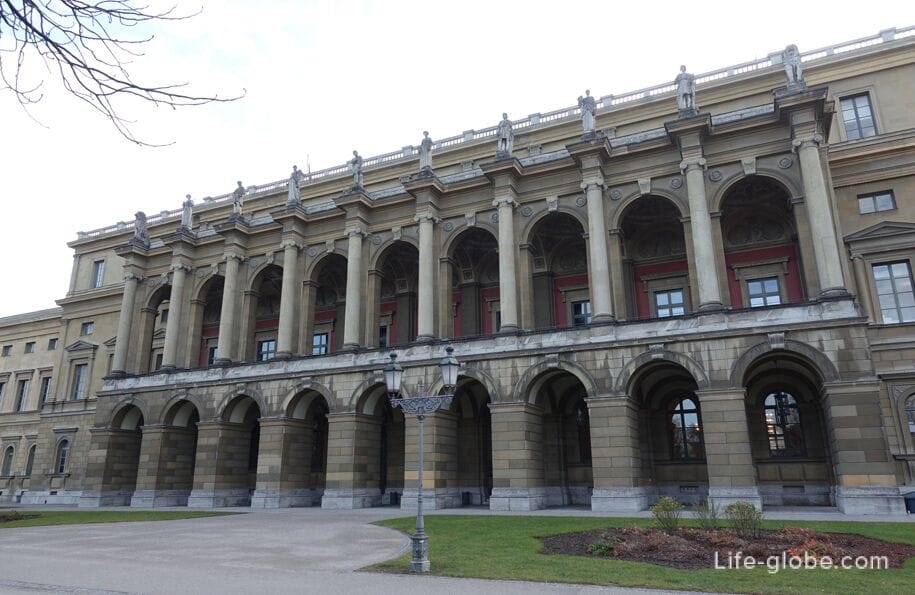
View of the residence from the street gigolo-Goppel Strasse (Alfons-Goppel-Straße) near the Bavarian Academy of Sciences (Bayerische Akademie der Wissenschaften).
Here you can see the fountain in the crown-the relative importance-Brunnen (Kronprinz-Rupprecht-Brunnen) built in commemoration of the 200th anniversary of the Bavarian Academy of Sciences and in memory of the crown Prince relative importance. The upper part of the fountain is decorated with a sculpture of the goddess of justice.

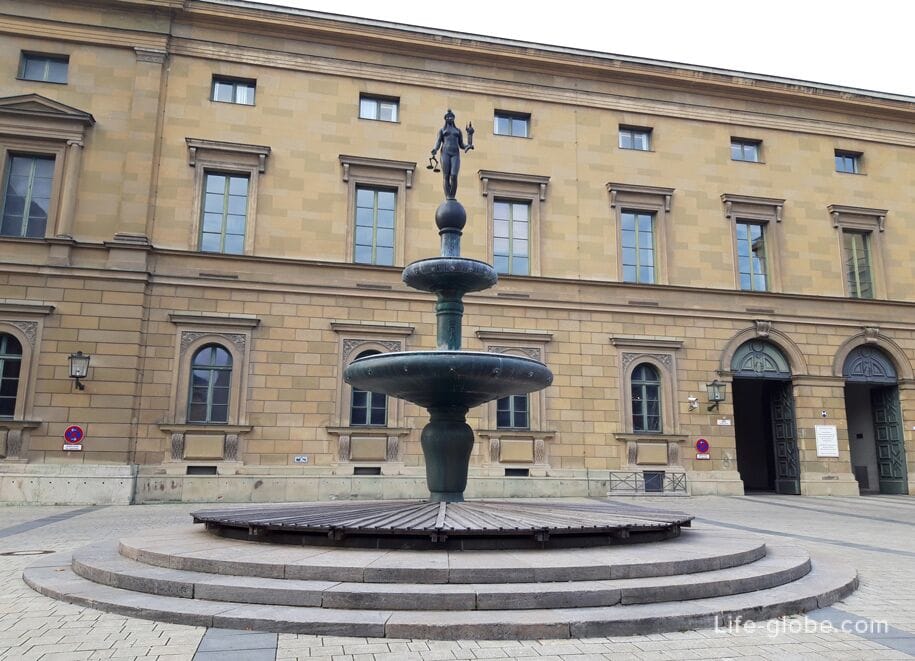
Museums and theatre in the Munich residence
Even during the reign of king Ludwig I, interested citizens could by appointment and in the days when the Royal couple had not lived in the residence, to visit some rooms of the Royal chambers (Konigsbau).
When Regent Luitpold you can visit all unvisited part of the Palace and the old Treasury. In 1897 was published the first guide to the Munich residence.
After the revolution of 1918, when king Ludwig III, left his room, and Bavaria was declared a Free state, - the internal premises of the Palace complex became a public Museum in 1920.
Entrance to museums and to the theater of the residence paid.
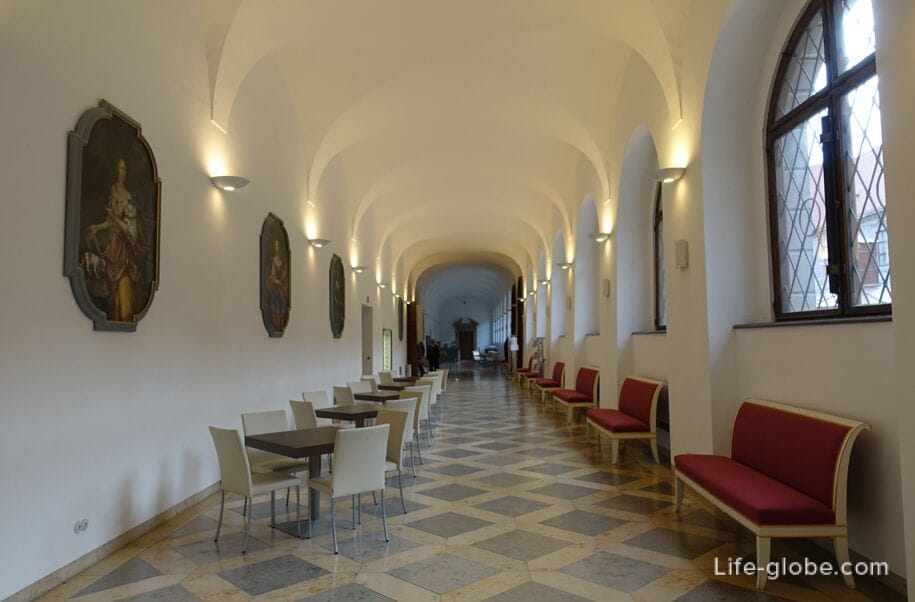
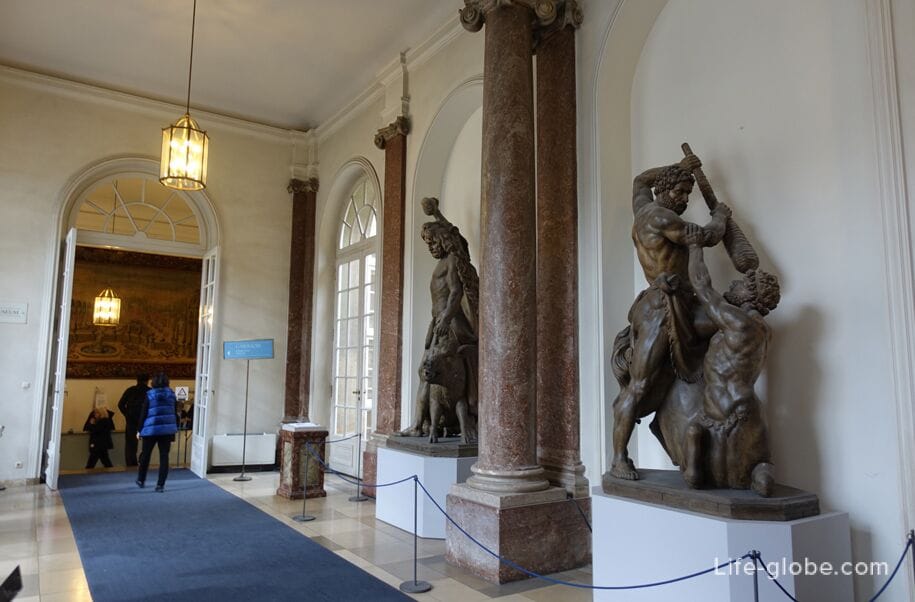
Residence Museum
Residence Museum (Residenzmuseum) consists of 130 rooms, many of which are richly decorated, have valuable collections of works of art, antique furniture and interior items.
The rooms of the Museum are a testimony to the lives of their owners - the Bavarian rulers: from the 16th to the 19th century eras of Renaissance, Baroque, Rococo, classicism and historicism.
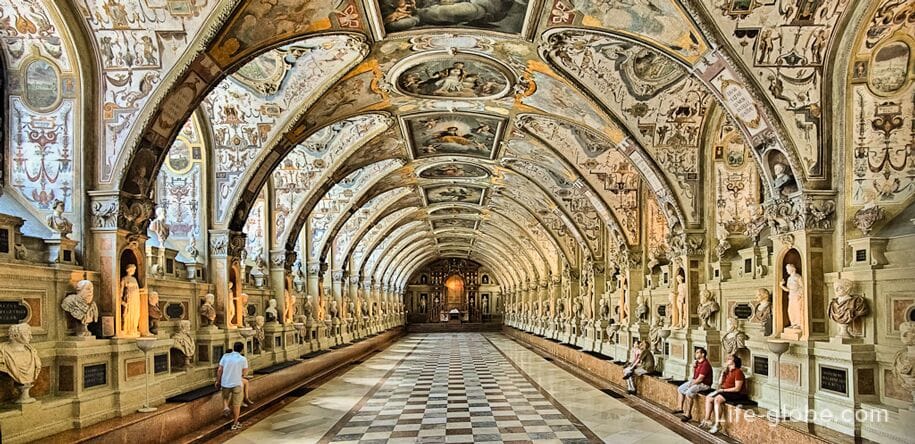
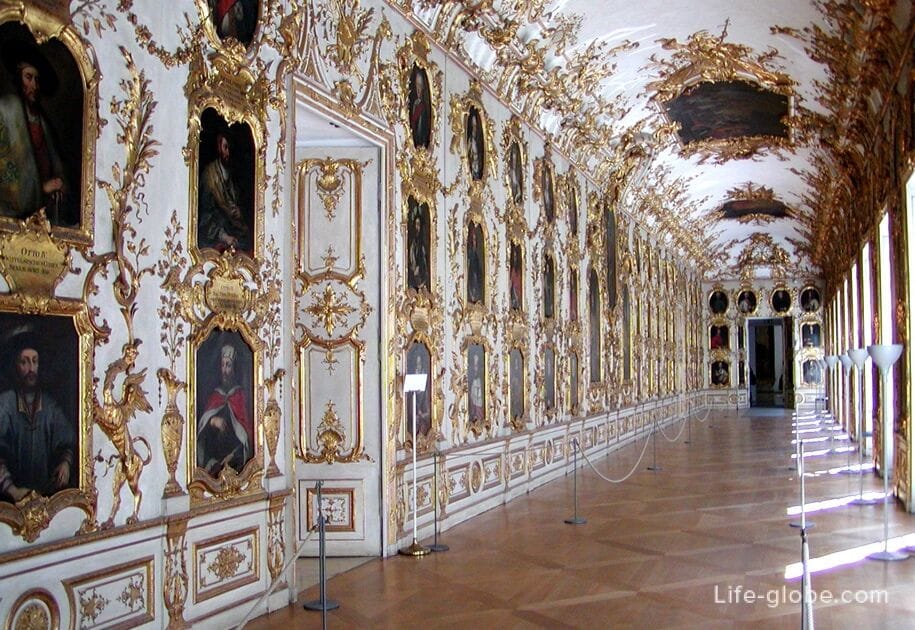
The Museum residences are also located in the court chapel and its rich chapel of Maximilian I and his wife.
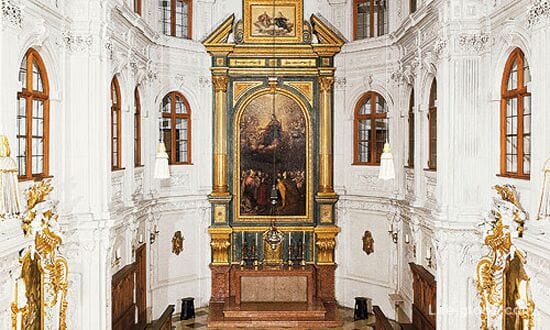

Treasury residence
Treasury or the Treasury of the residence (Schatzkammer) was founded by Duke albert V in 1565 and today consists of ten rooms, located in the East wing of Konigsbau.
Collection of the Treasury is one of the most important in the world and has 1000 years of history: from the early middle ages to neo-classicism.
The collection includes: the Royal insignia, the Royal prayer book, crowns, swords, goblets, the work of jewelers, rhinestone, ivory, icons, relics, and numerous other treasures like precious tableware and toiletries.
9 room of the Treasury located art gallery, which includes valuable works of art.
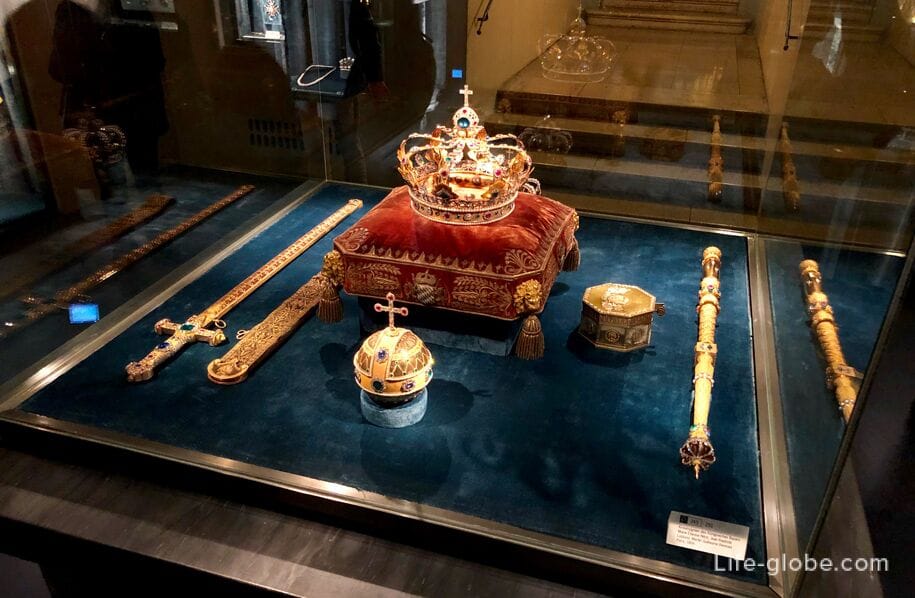
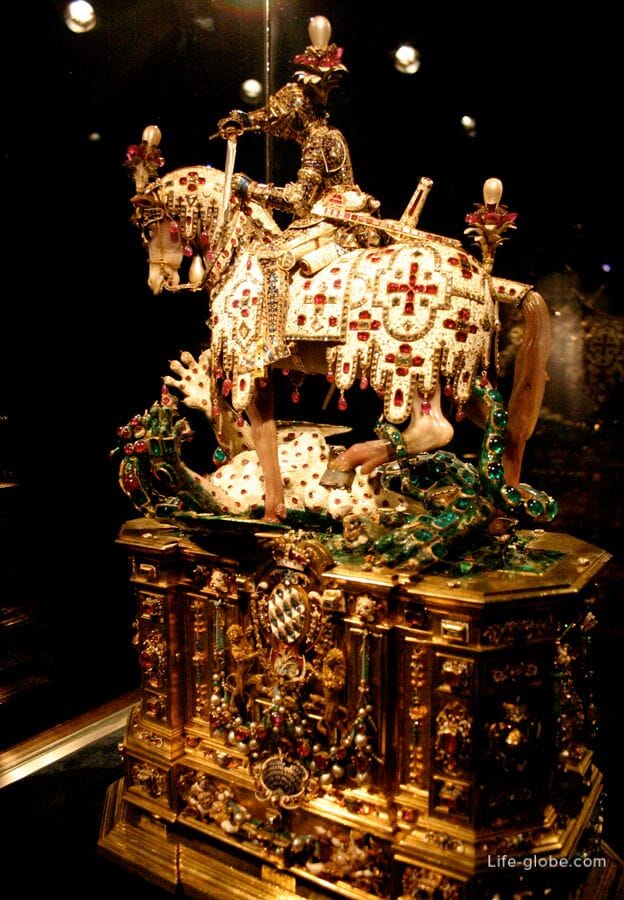
The layout of the Treasury in the Munich residence (marked in yellow)
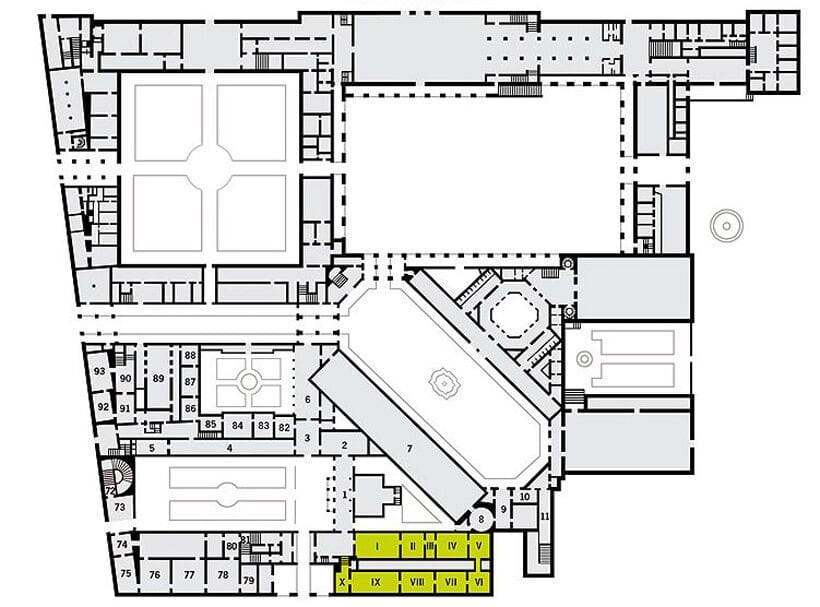
Cuvillies-Theater
Cuvillies-theater (Cuvillits-Theater) or old residence theatre residence theatre is the former court theatre of the residence and today one of the most important and beautiful Rococo theaters in Germany.
The theatre was created in 1751 from more than 1000 trees cut down at the lake Staffelsee (Staffelsee) and was originally intended exclusively for the Palace. It was built in the immediate vicinity of the residence, in the place where now stands the (New) Residence Theatre, on the square of max Joseph. For story time at the theater were many famous operas, including the premiere of Mozart's "Idomeneo" in 1781.
During the Second world war (18 March 1944) the theatre building was destroyed. In its place, in the years 1948-1951, was erected the so-called "New theatre residence", which today is still in its previous location. But still, the old theatre, was moved to a wing of the Munich residence, which was reconstructed in the 1950s and reopened in 1958 under the name "Cuvillies Theatre" with a performance of Mozart's "the marriage of Figaro."
Old theater residence today is only part of the original, decorated in red and gold tones, has four floors of loggias and visual series.
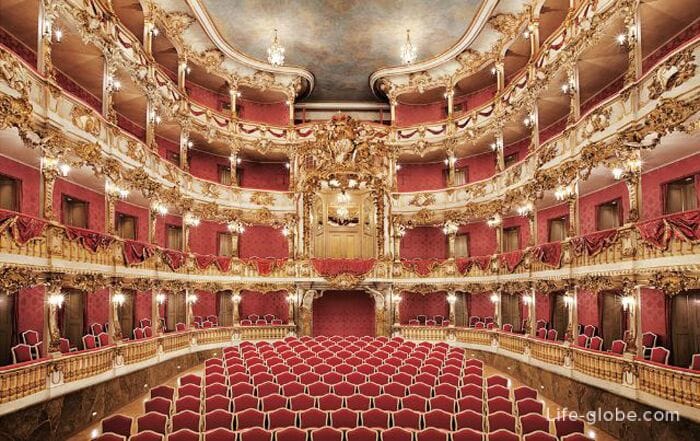
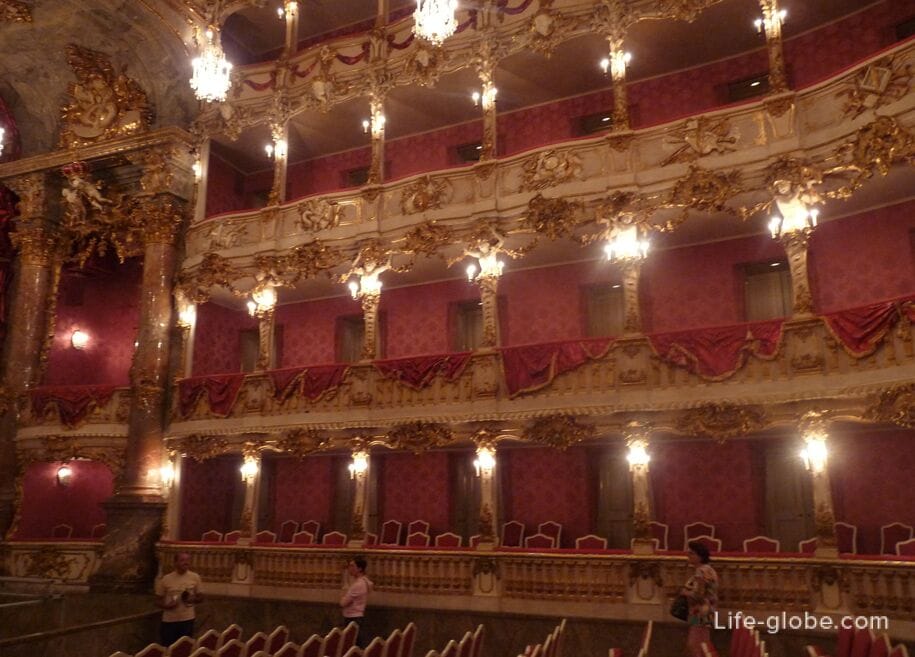
The layout of the old theater residence (marked in red)

Photos of the new theatre residence (Residenz Theatre) on the left and the National (Opera house) theatre (on the right, the building with columns) in the square of max Joseph
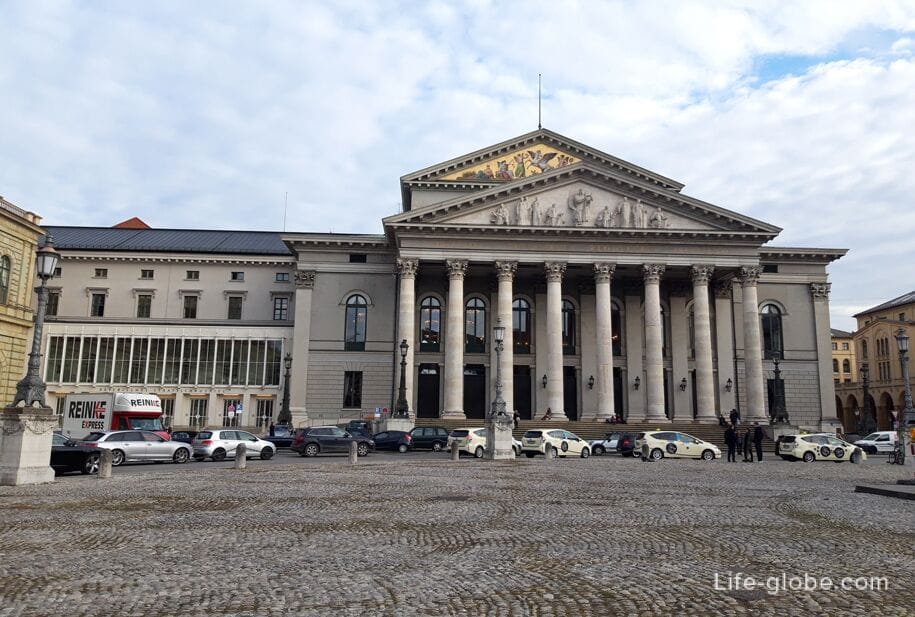
The collection of coins
The Munich state collection of coins or the state coin collection Munich (Staatliche Münzsammlung München) today located in the walls of the Munich residence, and is one of the world's leading and one of Europe's oldest collections of this kind.
The history of the collection dates back to the second half of the 16th century, when the Renaissance princes and wealthy individuals began to collect all sorts of rare and precious things: the work of jewelers, sculptures, paintings, engravings, curiosities, scientific instruments, and numerous coins.
The numismatic collection consists of about 300,000 copies from antiquity to modern times: coins, paper money, medals, securities, and faceted stones. The oldest piece in the collection date from the 3rd Millennium BC.
When the Munich collection of coins operates a library with over 26,000 volumes of books.
The scheme of location of the collection of coins in Munich residence (marked in red)
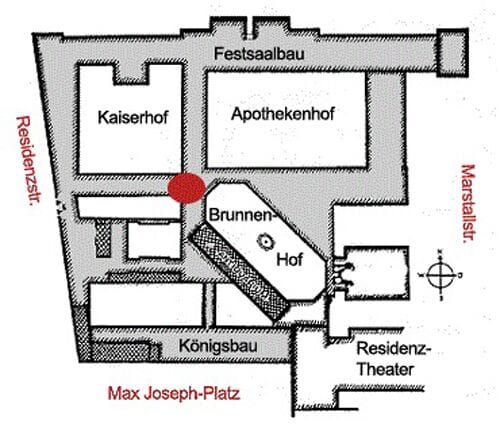
Courtyards Munich residence
In the structure of the Munich residence are 10 internal courtyards, which are characteristic of the residence, each of which is different from the others in shape and size, as well as attractive in their own way.
Most of the yards were established in the ongoing construction of the extension of the Palace in the course of erection and connection of the new with the older wings. While other courts, such as the courtyard of the Committee, opened in 1958, or a cozy Armchair next to the garden court of the temple, found its present form only during the reconstruction after the Second world war.
During the Bavarian rulers courtyard with a fountain and the Imperial court were of great importance as the reception area and access to the residence, as well as a place for courtly festivities and ceremonies.
The entrance to the courtyard of the residence is free.
The Imperial court
The Imperial court or the Kaiserhof (hotel Kaiserhof) was erected between 1612 and 1616 years after Maximilian I built the wings with a tower-the residence as a clock tower around the yard. At that time the Imperial court was opened just for the ceremonies of high level.
Today, the facades of the buildings around the courtyard is decorated with optical illusions, and on the eve of Christmas and New year at the Imperial court operates Christmas market (Weihnachtsmarkt), which is filled with tents and kiosks which sell drinks, including a warming mulled wine, snacks, sweets, Souvenirs, etc.
The courtyard out to the street Residenciales through one of two portals, portal flanked by two lions.
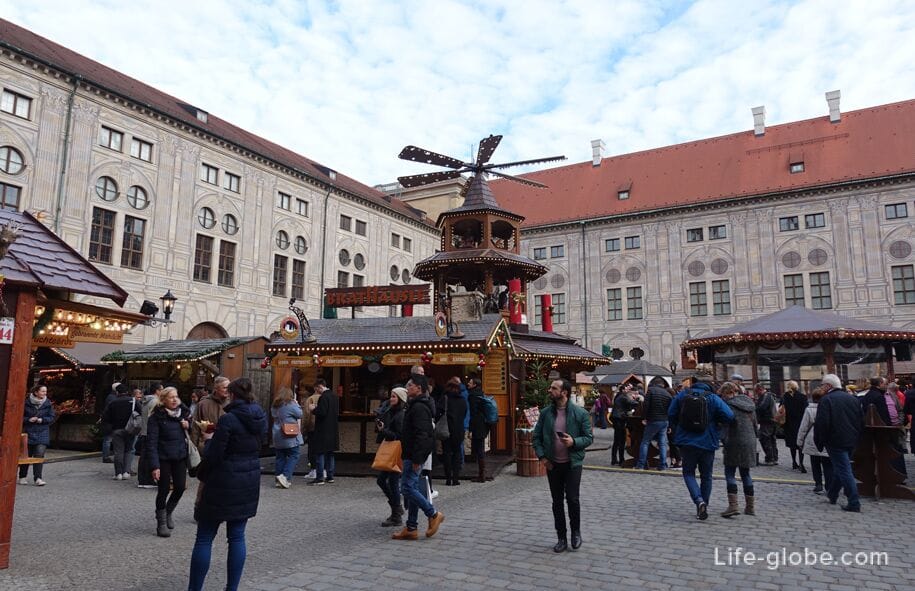
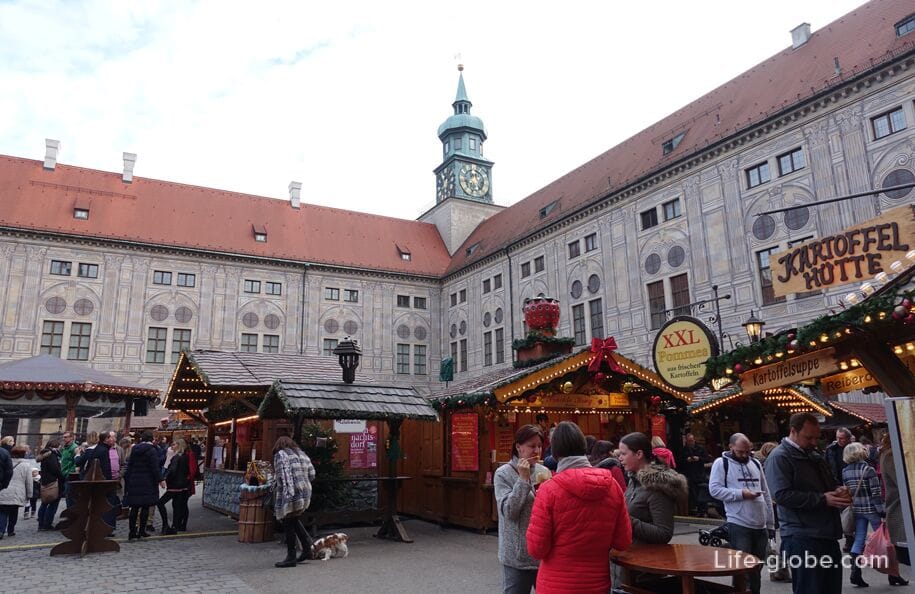
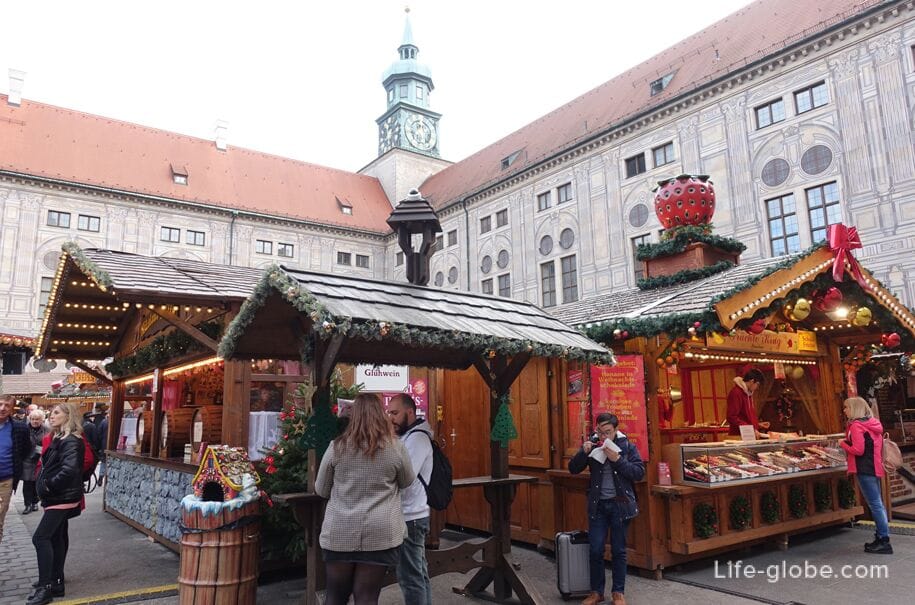
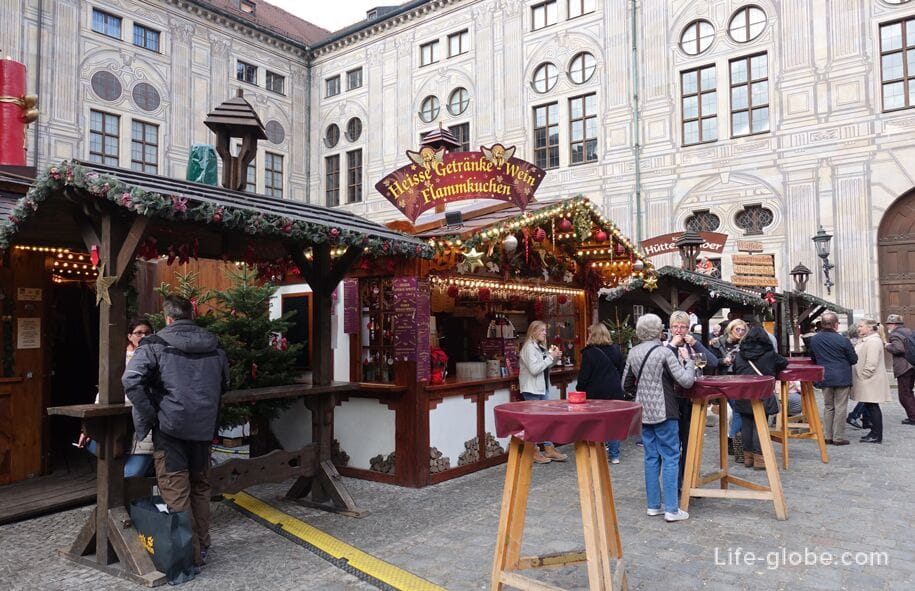
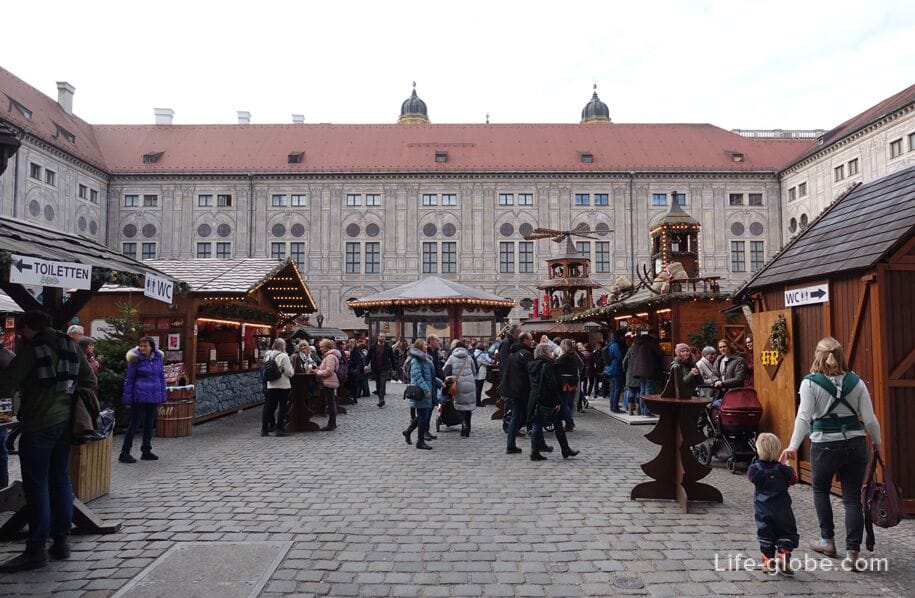
Pharmacy courtyard
Pharmacy courtyard (Apothekenhof) was originally created under Maximilian I and now is the largest of the courtyards Munich residence.
Since 1832 under king Ludwig I, the architect Leo von Klenze created a new wings in this area of the residence. While the new "Ball building" on the North side of the courtyard overlooking the Park Hofgarten placed halls the mission of the monarchy, of the court pharmacy is located in the East wing relative to the yard, where he worked as Max von Pettenkofer (1818-1901), was (today there is cuvillies-theater). Since then, the term "chemist's court yard" has become commonplace to refer to court.
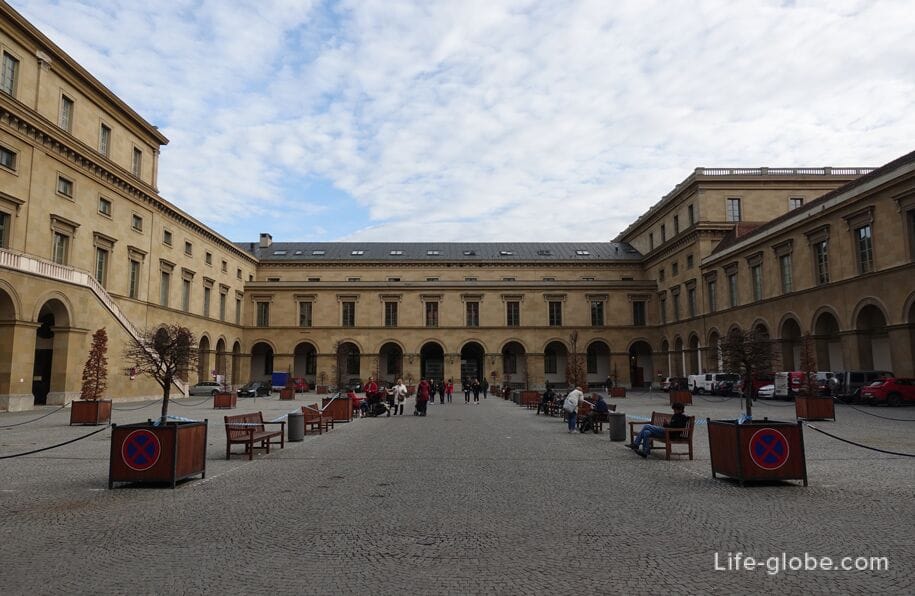
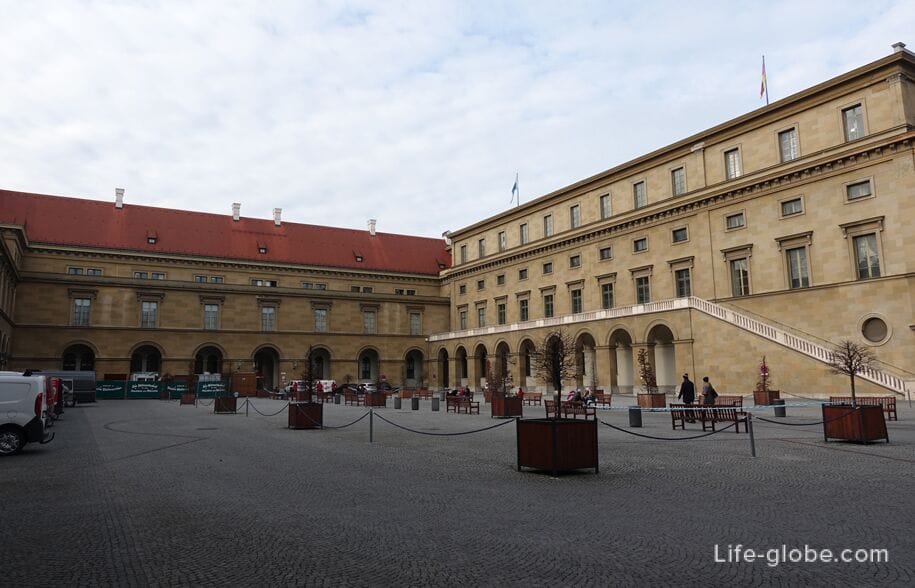
The yard of the chapel
The yard of the chapel or Kapellenhof (Kapellenhof) arose when the court was erected a chapel in the early 17th century.
This narrow courtyard is named in honor of the chapel and directly faces the street Residenciales through the second (South) mighty portal flanked by two lions.
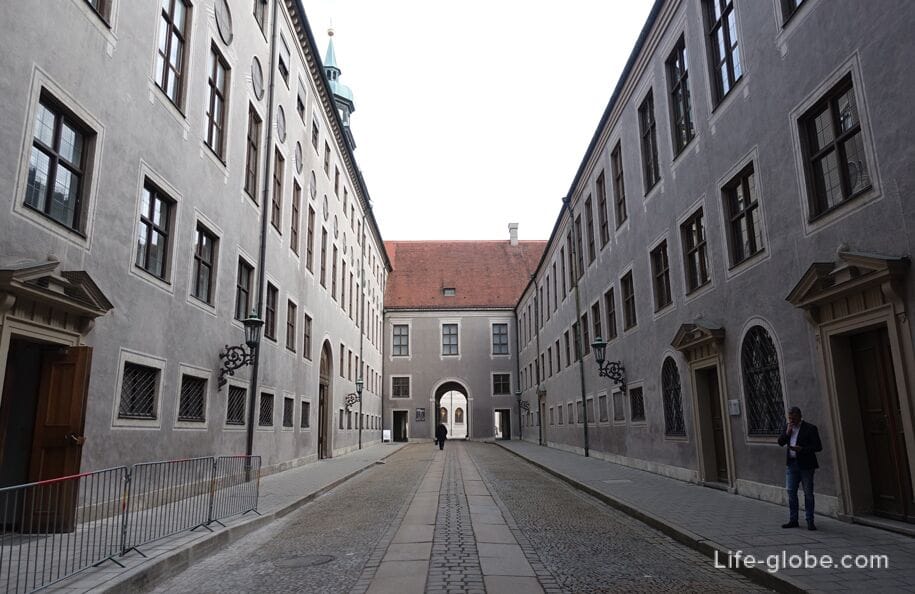
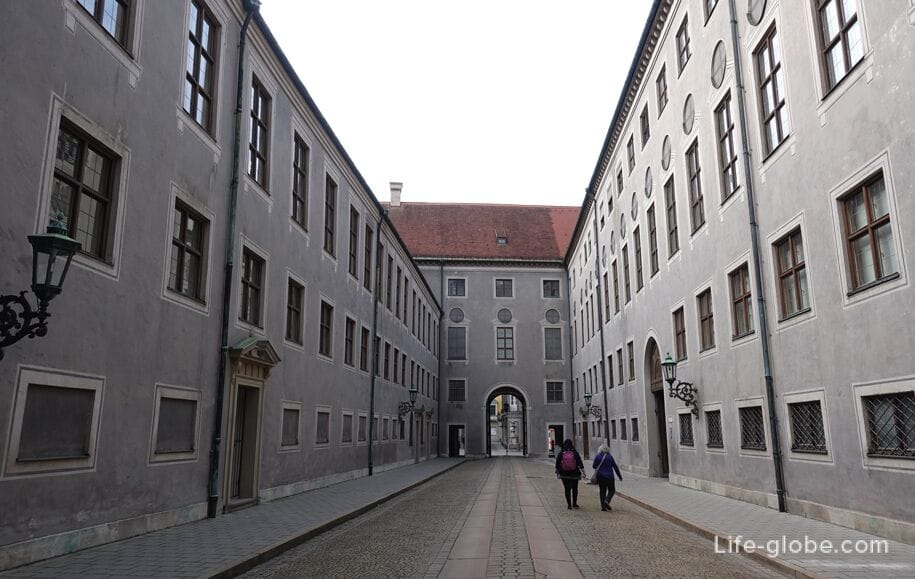
Courtyard with fountain
Courtyard with a fountain or Brunnenhof in the 17th century several times served as a venue of the tournaments.
This octagonal courtyard elongated owes its name located in the center of the courtyard the fountain of Wittelsbach (Wittelsbacherstrasse / Wittelsbacherbrunnen), which is topped by a bronze statue of Otto I, who became the first Bavarian Duke of the Wittelsbach dynasty.

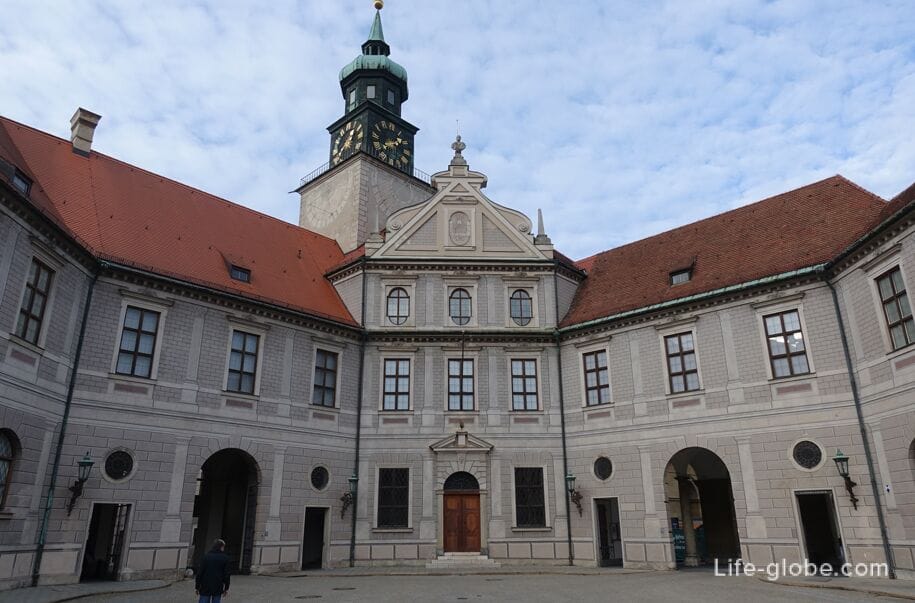

Yard "garden area"
Dvor "Office garden" / "garden office" or Kabinettsgarten is located between the classical wings of the residence, built after 1832 between drug court and the court Church of All Saints.
At that time the courtyard of the square Marstallplatz was inside the wall, and he could enter only through a narrow passage. Introducing a closed room in the garden, yard called armchair garden.
Today, as before, this small courtyard is located on the Eastern edge of the residence and is a landscaped garden with a fountain, small water tanks, sculpture and places to relax.
The garden was awarded the Deutschen Landschaftsarchitekturpreis 2005 (German landscape architecture award) and nominated for DBA 2006. He is described as a "little gem", which conveys a "serene atmosphere" and "charming mood".
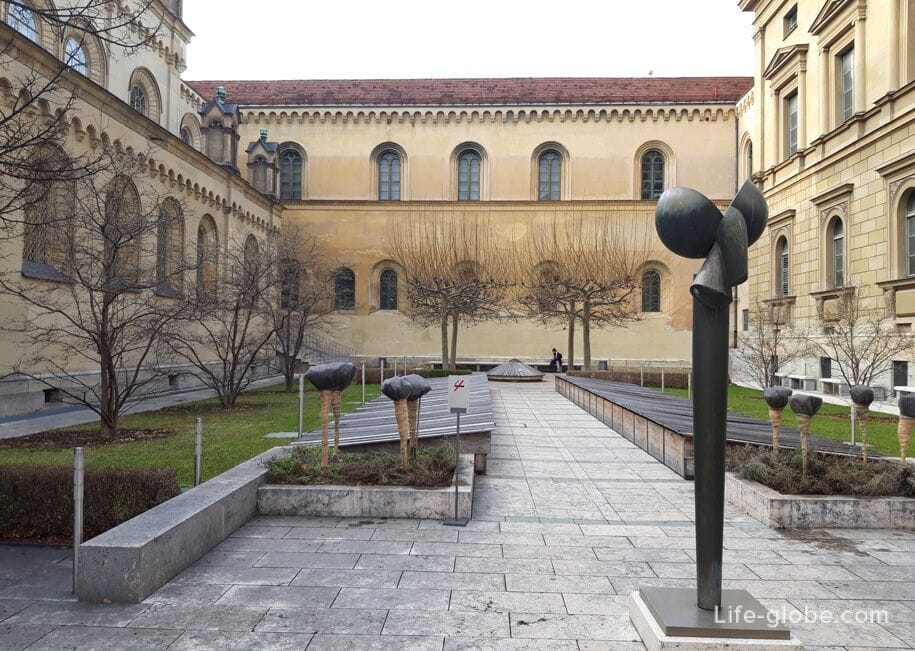
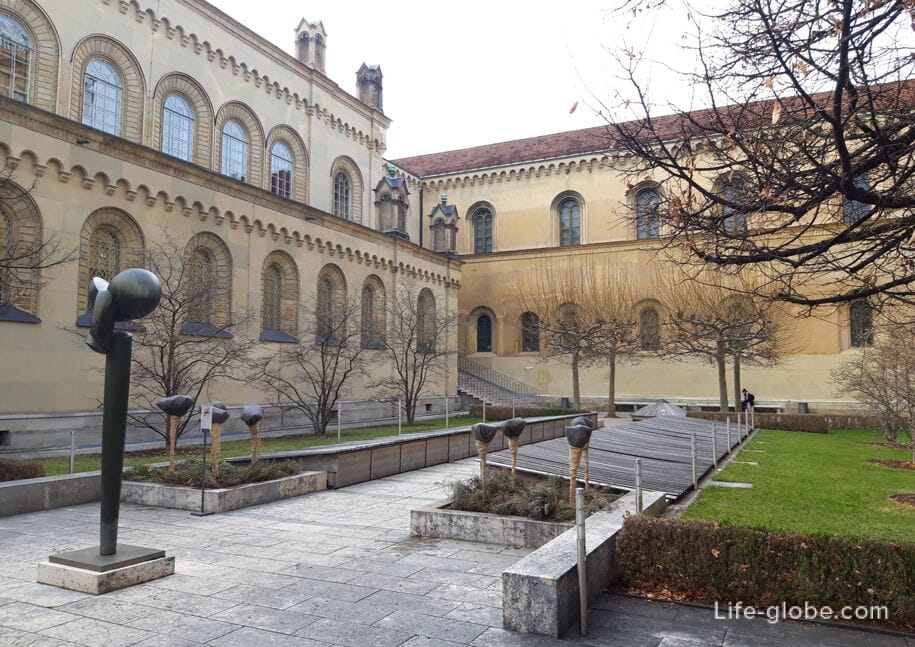
Courtyard Of The Grotto
Courtyard of the Grotto or Grottenhof was built between 1581 - 1586 years when William V Friedrich Sstream as a leading architect and received its name from the fountain in the courtyard and antique limestone on the West facade.
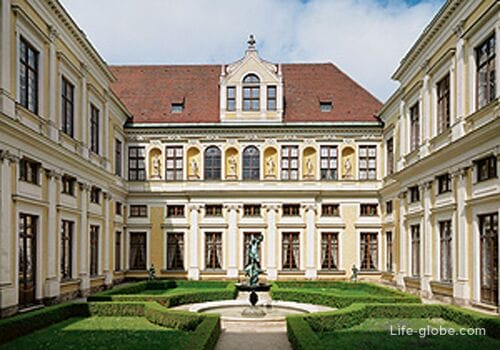
The Royal court
The Royal court or Kenigsberga (Königsbauhof) originated as part of a residential Palace for king Ludwig I and was built on the site of the old garden.
Today in the Royal courtyard are sculptures and places to relax.
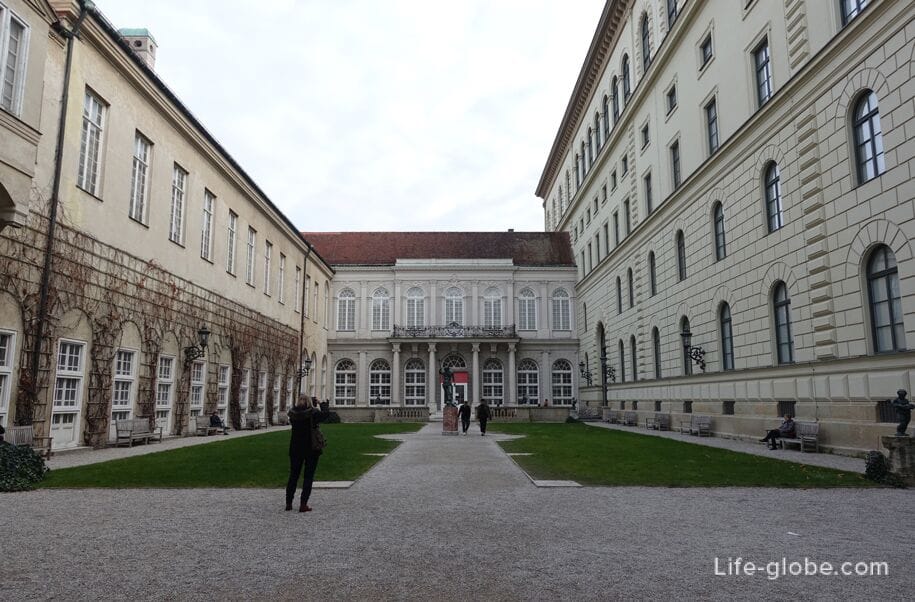
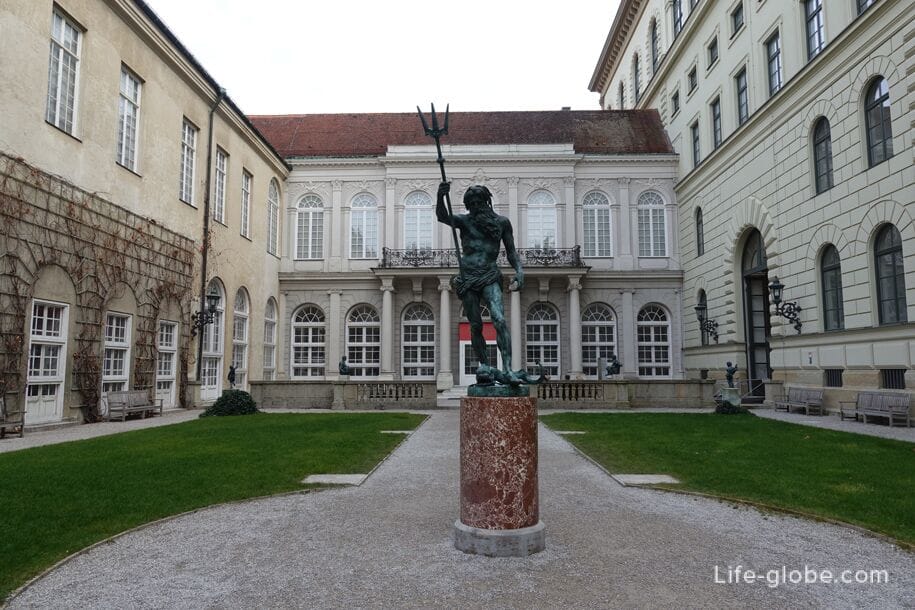
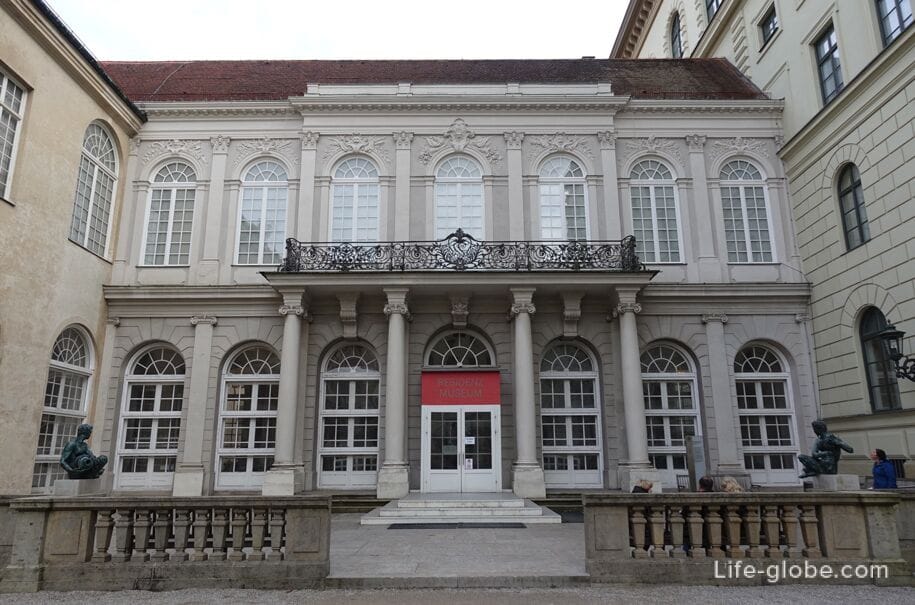
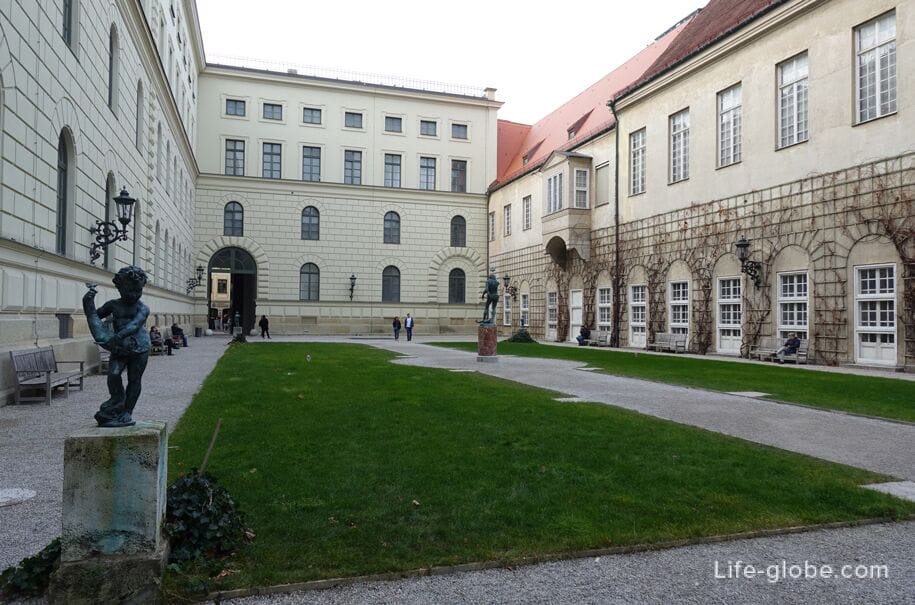
The Yard Committee
Yard or Komitaji Committee (Comite-Hof) the nanny is not a court in its truest sense of the word, but is part of the old theater residence.
During the recovery residence after damage of the Second world war, in the reconstruction of the cuvillies-theater, which was completed in 2008, former court Terheggen was redesigned and got a glass roof. It has also been renamed the "Comite-Hof".
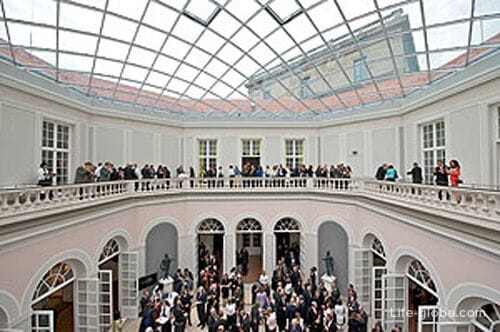
Powdery yard
Powdery yard (Puderhöfchen) is a small triangular courtyard, located in the southern part of the residence, which received its name from the premises where stored and powdered wigs worn in the 18th century.
This part of the residence, the room nutrivene of wigs including, was destroyed in 1944. The yard is currently not available.
Kitchen garden
Kitchen yard (Küchenhof), located next to the Green gallery (originally the place for glamorous celebrations), was built by Prince Regent Luitpold in 1897 and is now in the Museum Treasury. Got its name from being placed on the first floor of the kitchen.
During the reconstruction after the damage of world war II, the former kitchen was renovated and became part of the Treasury of the Munich residence.
Scheme courtyards Munich residence (marked in blue)
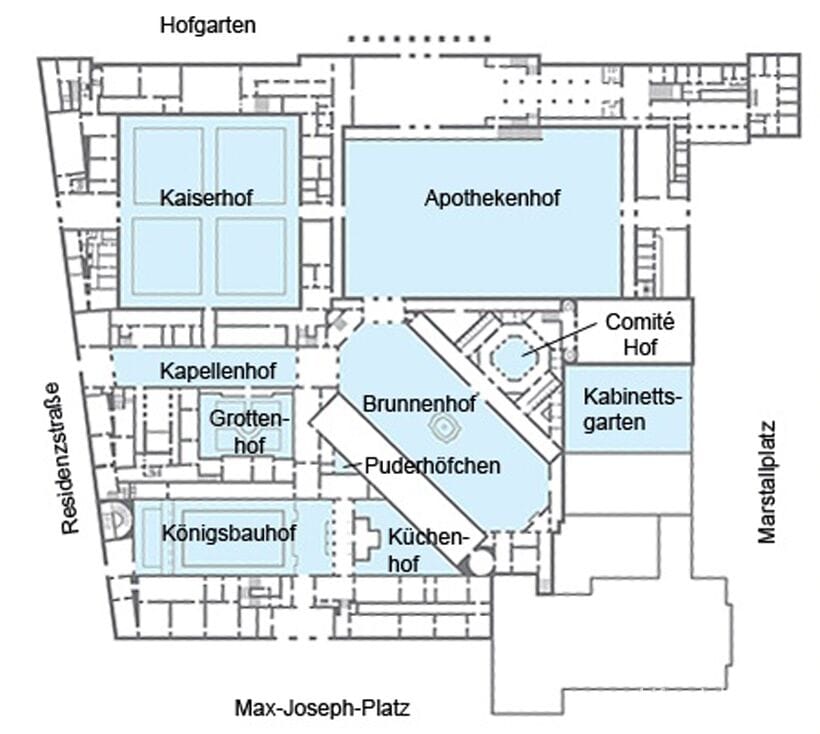
The Hofgarten Park
Park Hofgarten was built as the Munich garden in the courtyard outside the flat of former fortifications, expanded and changed from 1613 modeled on the gardens of the Italian Renaissance, along with new and additional buildings of the residence of Duke Maximilian I.
Today, this beautiful public Park is located on the North side of the Munich residence. Two sides are bordered by arcades. On the East side of the Park is the Bavarian state Chancellery. Also in the Eastern part of the Park from 1920-ies is the Munich war memorial and the centre of the Park adorns the pavilion (temple of Diana), which was created by Sean Henry the Elder in 1615. Read more about Hofgarten Park...
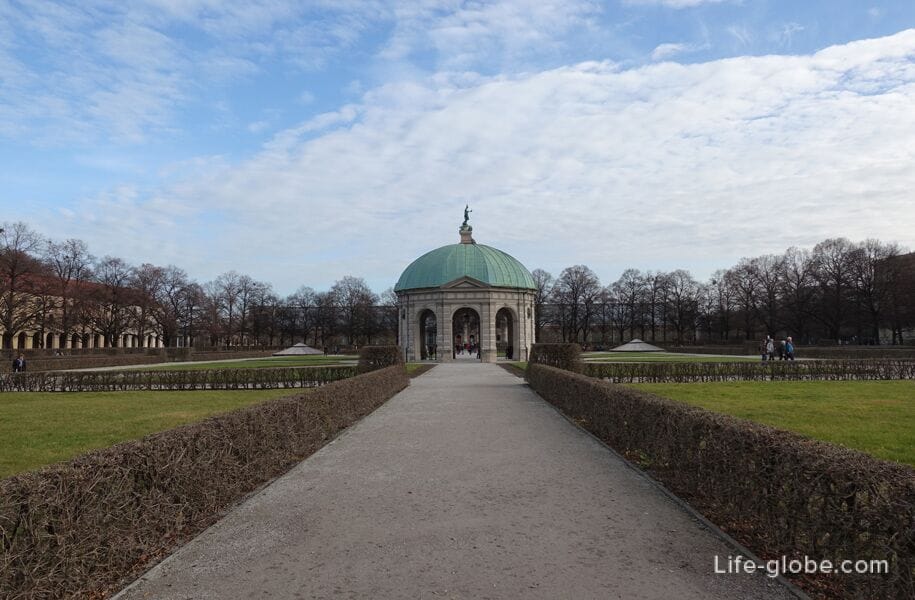
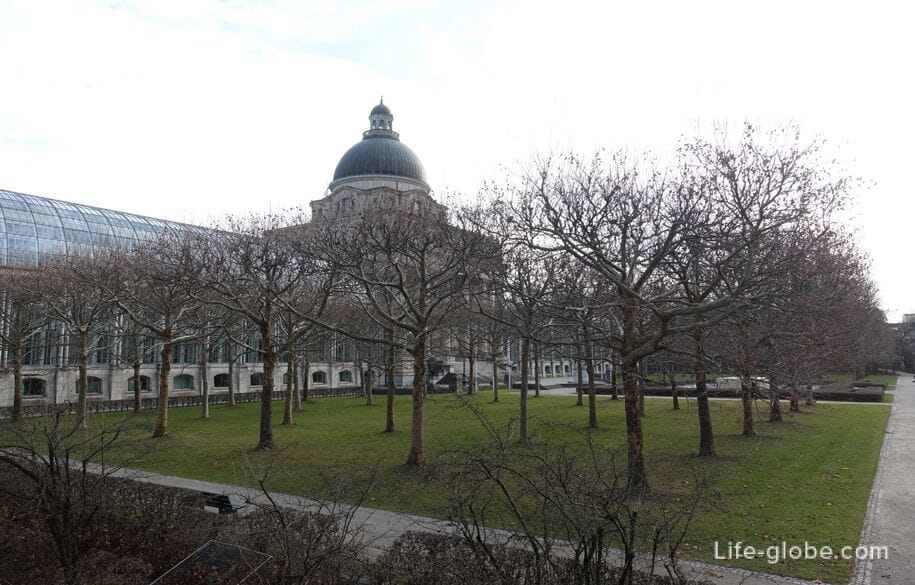
Court Church of All Saints
All Saints Church or the Hofkirche (Allerheiligen-Hofkirche) was built by architect Leo von Klenze in the years 1826-1837 under king Ludwig I on the East side of the residence as a Church court.
The construction of the Church was the inspiration of Ludwig the Cappella Palatina in Palermo in 1823.
The Church was designed with a private entrance for the king from the residence. The public entrance and went East to Marstallplatz and was designed in the Romanesque-Gothic style.
The vaults and apse of the new Church was initially covered with a colored painting on a gold background, and the walls - colored plaster and marble.
The interior of the Church, which was largely destroyed during the Second world war, was opened to the public only in 2003. During the reconstruction there was no attempt to recreate the original lost and the interior of the Shrine. The building is now used for concerts and events, within respect for its former importance - as a Church.
The Church is located next to the courtyard "garden area".


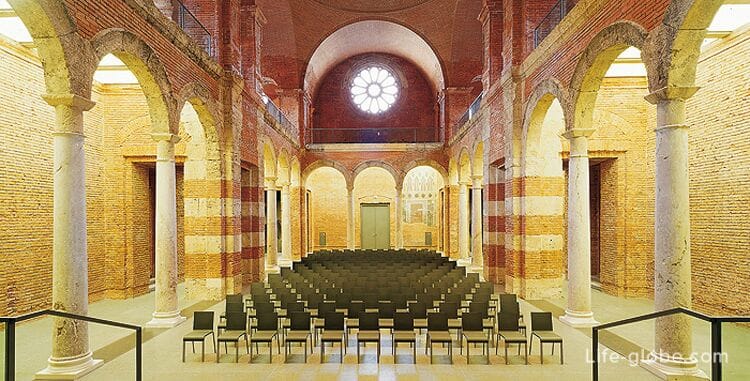
Practical information
The Munich residence is located in the Old town of Munich, near Odeonsplatz square (Odeonsplatz) and walking distance from the central square of the city of Marienplatz, at the address: Residenzstraße 1.
You can visit the Munich residence on your own or the Treasury of the residence and the Hofgarten Park with a tour of Munich:
You can visit the Munich residence yourself. Entrance fees:
- residence Museum: € 9 full ticket, € 8 - reduced;
- Treasury: € 9 full ticket, € 8 - reduced;
- the cuvillies - theater (entrance in the passage between the courtyard with a fountain and pharmacy building): 5 euros adults, 4 euros - reduced.
- combined ticket (residence Museum + Treasury): € 14 adults, € 12 - grace;
- General ticket (residence Museum + Treasury + cuvillies-theater): 17 euros full ticket, € 14,50 - discount;
- know what to do and teenagers up to 18 years stay free of charge.
Free audio guide available to the residence Museum and Treasury in the following languages: German, English, Italian, French, Spanish, Russian.
Tickets can be purchased at the box office Munich residence.
Museum Munich coin collection is separate. Open from Tuesday to Sunday from 10 to 17 hours. Admission: 3 euros adults, 2 euros – reduced, Sunday - 1 Euro, children under 18 years stay free of charge.
The hours of the library at Munich coin collection: Monday to Thursday from 9:00 to 16:00, Friday to 2 PM.
Attention! The cost of tickets and opening hours may vary, please specify the information directly before visiting.
The website of the Munich residence: residenz-muenchen.
The website of the Museum of the Munich coin collection: staatliche-muenzsammlung.
The layout of the Munich residence
